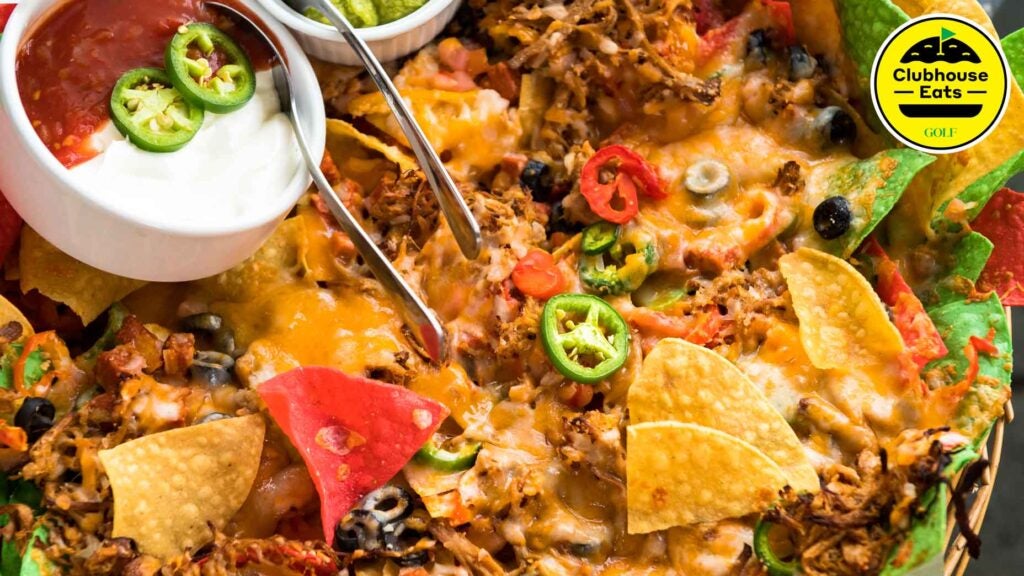Welcome to Clubhouse Eats, where we celebrate the game’s most delectable food and drink. Hope you brought your appetite.
***
The Super Bowl is right around the corner, and nothing goes better with the big game than an equally big platter of nachos. Brian Lieske, the executive chef at Grayhawk Golf Club, loves talking nachos, so we sat down with the West Coaster to chat — not about the San Francisco 49ers, whom he loved as a child, but to pick his brain about this ultimate game day snack. Here, we share Chef Lieske’s advice for making MVP-worthy nachos any time of the year.
The Most Important Components
There’s no shortage of options when it comes to the ingredients that make up a plate of nachos, but the most crucial, in Lieske’s opinion, are the ones that he thinks are obvious (though we argue they might get taken for granted). We’re talking about the chips and the cheese. “The chips cannot be too thin or too thick,” he explains. “Too thin and they’ll break under the weight of the toppings; if they’re too thick, the bite will be overly hard and dry.”
As for the cheese, avoid aged varieties — even a sharp cheddar will sabotage your efforts. “The cheese needs to be a variety that has enough moisture that it will melt correctly,” he says. “A combination of mild/medium cheddar and Monterey Jack is ideal.”
The Meat of the Matter
In the chef’s opinion, a good plate of nachos must include a protein; and at Grayhawk, the chefs use either thinly sliced chicken or ground beef. “The thing to keep in mind with the proteins is to make sure that the pieces are small enough to fit on the chip,” he advises. “Pieces that are too large are hard to scoop up, they might break your chip from the weight, and they’re hard to fit in your mouth. That’s why nicely seasoned ground beef works so well.”
If you’re adding a protein, it needs to be well-seasoned. This isn’t negotiable. And while some dishes require just a liberal sprinkling of salt and pepper, those two enhancers alone aren’t going to cut it when nachos are involved. “The protein needs to be well-seasoned with a good, smoky base, so make sure you add chili powder and smoked paprika,” Lieske urges. “After that, it’s all personal preference, but don’t skimp on the seasoning.”
Underrated Toppings
Don’t shy away from spiciness — in moderation, it’s a key flavor that Chef Lieske believes can elevate your nachos. “Very thinly sliced jalapenos add that extra layer of needed flavor,” he says. “Some people say that they don’t like spicy, but if the jalapenos are sliced super-thin, you won’t get much spice.”
Turning Up the Heat
You might think there are many ways to heat a platter of nachos. To do it optimally, however, only the broiler feature in your oven will work. “Heat them up on a metal sheet pan so that you can make a thin layer and not have to worry about a plate breaking because it gets too hot,” Lieske says. “But don’t walk away from it. Chips will burn quickly if left unattended under the broiler.”
Do’s and Don’ts
While you’ve likely been served impressive towers of nachos out at restaurants, that’s not a tactic that you should attempt to replicate at home. Piling the chips high, so says the chef, only creates uneven layers. “The chips need to be spread out in a very thin layer so that the toppings get onto all of the chips. If your base of chips is too thick, you’ll end up with a lot of ‘naked’ chips at the bottom.”
Because the heating process needs to be fast, you must think preemptively. This means heating any cold toppings before you add them to the chips; otherwise, you’re chips will suffer as you wait for cold toppings to warm up to the necessary temperature. “If you don’t heat the nachos up fast enough,” Lieske says, “the chips will become soggy. Nobody wants that.”
Nobody wants underwhelming nachos, either. “You don’t want to be known as the one who serves bland nachos,” he says. “So season the ingredients more than you think you should.”
